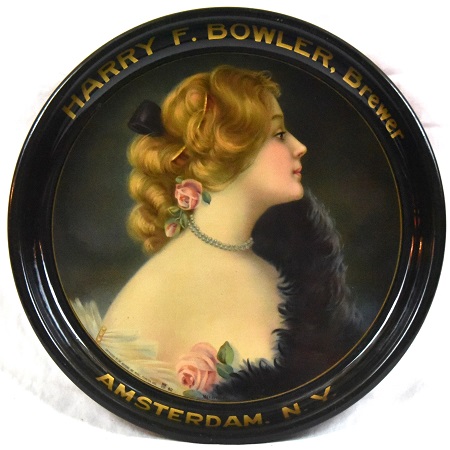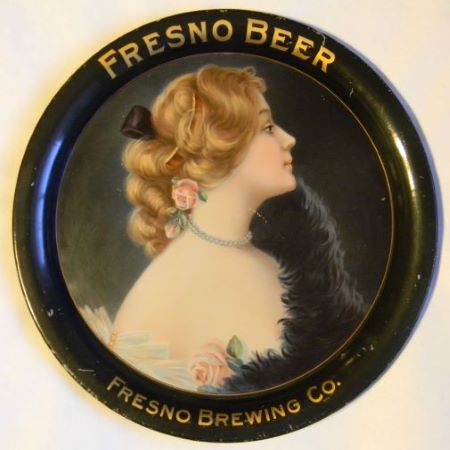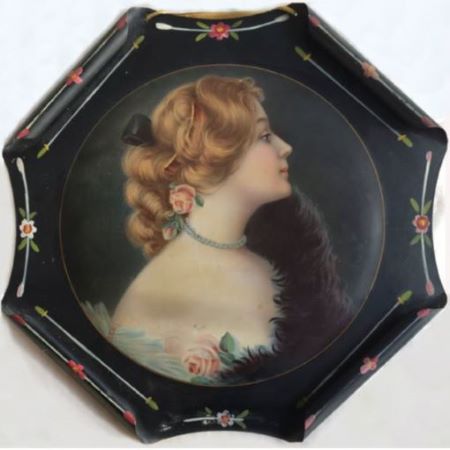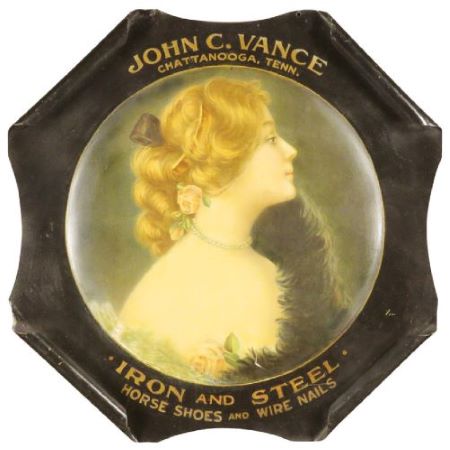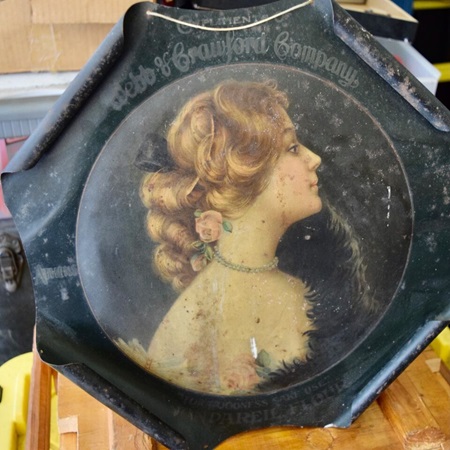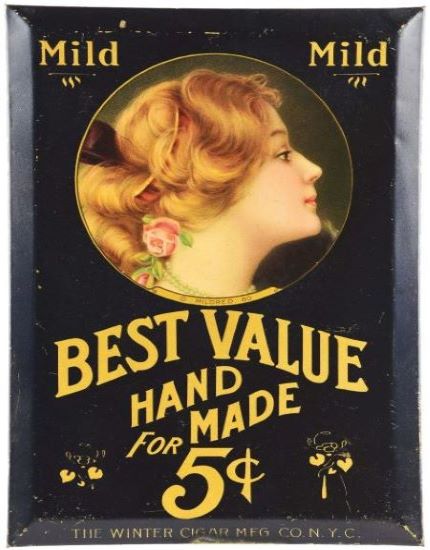The 'Stock' Exchange
The Meek Co. - American Art Works: No. 80 "Mildred"
The Meek Co. - American Art Works: No. 80 "Mildred"
Date: 1907 - 1914
Size: 13"
Type: Inverted Pie
13" Pie
& 13" x 13" Square Pie
Scarcity: Common
Value: $$$ to $$$$$
Condition & Brewer Dependent
Size: 13"
Type: Inverted Pie
13" Pie
& 13" x 13" Square Pie
Scarcity: Common
Value: $$$ to $$$$$
Condition & Brewer Dependent


General
No. 80 “Mildred” is probably the most successful design from the initial set of “Victorian Lady” designs as evidenced by the number of issuers and the length of duration in the catalog. Originally produced when the company was still operating as Meek Co. (based on the 1907 copyright date), it survived the transition from Meek Co. to American Art Works which occurred in late 1909. Some examples of this designs say “American Art Works, successors to the Meek Company.” Like the similarly popular “Annabelle” (No. 65) the attractive subject is captured in profile from the chest up, the only two “Victorian Ladies” to appear this way other than the mysteriously scarce “Rosamond” (No. 81).
Mildred is an Anglo-Saxon name of Old English origin, composed of "mild" ("mild") + "þryð" ("power, strength", also present in the last syllable of the name Audrey), meaning "gentle strength". It reached the rank of the sixth most popular name for girls in the United States in 1912 and maintained that popularity through 1920, but then its popularity dropped quickly afterward. Familiar forms include Milly and Midge.
We suspect that the design is not a reproduction of existing artwork by an outside artist; however, it is possibly inspired by the title character of Mary J. Holmes 1877 novel Mildred. Mary Jane Holmes (April 5, 1825 – October 6, 1907) was a bestselling and prolific American author who published 39 popular novels, as well as short stories. Her first novel sold 250,000 copies; and she had total sales of 2 million books in her lifetime, second only to Harriet Beecher Stowe. In the novel, Mildred is abandoned as an infant, but grows up to be an intelligent, beautiful young lady who then is confronted with difficult choices involving love and marriage.
While “Mildred” is similar in the formality of her pose and attire to other “Victorian Lady” designs, the distinguishing feature is her boa. While documentation of the evolution of whimsical women’s accessories is lacking, unlike today (where boas are usually only worn by performers in an ironic/kitschy kind of way ) in the 19th century, boas were synonymous with high social-standing, often made from exotic specifies such as ostriches, turkeys, marabou, and chandelle. Feather boas have been documented for use as an adornment since at least 1820, but they might have been worn as early as the 17th century. Feather boas have fallen in and out of fashion many times over the years. Some historic eras where feather boas were in style or trendy include: the late Victorian era and Edwardian era (between 1890 and 1915), the 1920's, the 1970's during the glam rock and disco music eras, and in the rave scene of the 1990's.
There were also boas made from fur which was also a luxury item, although these seem to have been less common. The death of the once-thriving plume trade was in part due to Congress passing the Migratory Bird Act of 1913, (which “prohibited spring hunting of migratory birds,” and later due to the Great Depression.
One of the more interesting examples is a tip tray with “Charlotte Cushman, pick of the market” with no location information. Charlotte Saunders Cushman (1816 – 1876) was an American stage actress. Her voice was noted for its full contralto register, enabling her to play both male and female parts. She lived intermittently in Rome, in an expatriate colony of prominent artists and sculptors, some of whom became part of her tempestuous private life. But why would anyone issue an advertising piece for a long dead actress?
Sahling did have an entry in his workbook in May 1907 for “Stock 13” tray Mildred.”
Size, Shape & Message Placement
As a full-size tray this design occurs most frequently as a concave pie, with a few convex pies, squares and small oblongs occasionally popping up. We have seen a single stock example of an oval version but never one with advertising It also appears as curled corner signs, Dresden Art Plates, and probably most frequently of all, as a tip tray. Rims are black with gold advertising text.
Hager & Price
Hager discusses this design in “The Ladies” subsection, mostly noting that it is among a series of designs that appear as both trays and Dresden Art Plates and that Mildred is the most common. He also includes her in his date of introduction table with a date of 1907 and in his catalog. Given the large number of examples, prices tend to range quite a bit with above average brewery trays going in the low-to-mid three figures and non-brewers in the high double to low triple digits. Among the highest prices are examples from cigar manufacturers, including $2,100+ for a very good condition round sign example from Reinkens Havana Cigars.
No. 80 “Mildred” is probably the most successful design from the initial set of “Victorian Lady” designs as evidenced by the number of issuers and the length of duration in the catalog. Originally produced when the company was still operating as Meek Co. (based on the 1907 copyright date), it survived the transition from Meek Co. to American Art Works which occurred in late 1909. Some examples of this designs say “American Art Works, successors to the Meek Company.” Like the similarly popular “Annabelle” (No. 65) the attractive subject is captured in profile from the chest up, the only two “Victorian Ladies” to appear this way other than the mysteriously scarce “Rosamond” (No. 81).
Mildred is an Anglo-Saxon name of Old English origin, composed of "mild" ("mild") + "þryð" ("power, strength", also present in the last syllable of the name Audrey), meaning "gentle strength". It reached the rank of the sixth most popular name for girls in the United States in 1912 and maintained that popularity through 1920, but then its popularity dropped quickly afterward. Familiar forms include Milly and Midge.
We suspect that the design is not a reproduction of existing artwork by an outside artist; however, it is possibly inspired by the title character of Mary J. Holmes 1877 novel Mildred. Mary Jane Holmes (April 5, 1825 – October 6, 1907) was a bestselling and prolific American author who published 39 popular novels, as well as short stories. Her first novel sold 250,000 copies; and she had total sales of 2 million books in her lifetime, second only to Harriet Beecher Stowe. In the novel, Mildred is abandoned as an infant, but grows up to be an intelligent, beautiful young lady who then is confronted with difficult choices involving love and marriage.
While “Mildred” is similar in the formality of her pose and attire to other “Victorian Lady” designs, the distinguishing feature is her boa. While documentation of the evolution of whimsical women’s accessories is lacking, unlike today (where boas are usually only worn by performers in an ironic/kitschy kind of way ) in the 19th century, boas were synonymous with high social-standing, often made from exotic specifies such as ostriches, turkeys, marabou, and chandelle. Feather boas have been documented for use as an adornment since at least 1820, but they might have been worn as early as the 17th century. Feather boas have fallen in and out of fashion many times over the years. Some historic eras where feather boas were in style or trendy include: the late Victorian era and Edwardian era (between 1890 and 1915), the 1920's, the 1970's during the glam rock and disco music eras, and in the rave scene of the 1990's.
There were also boas made from fur which was also a luxury item, although these seem to have been less common. The death of the once-thriving plume trade was in part due to Congress passing the Migratory Bird Act of 1913, (which “prohibited spring hunting of migratory birds,” and later due to the Great Depression.
One of the more interesting examples is a tip tray with “Charlotte Cushman, pick of the market” with no location information. Charlotte Saunders Cushman (1816 – 1876) was an American stage actress. Her voice was noted for its full contralto register, enabling her to play both male and female parts. She lived intermittently in Rome, in an expatriate colony of prominent artists and sculptors, some of whom became part of her tempestuous private life. But why would anyone issue an advertising piece for a long dead actress?
Sahling did have an entry in his workbook in May 1907 for “Stock 13” tray Mildred.”
Size, Shape & Message Placement
As a full-size tray this design occurs most frequently as a concave pie, with a few convex pies, squares and small oblongs occasionally popping up. We have seen a single stock example of an oval version but never one with advertising It also appears as curled corner signs, Dresden Art Plates, and probably most frequently of all, as a tip tray. Rims are black with gold advertising text.
Hager & Price
Hager discusses this design in “The Ladies” subsection, mostly noting that it is among a series of designs that appear as both trays and Dresden Art Plates and that Mildred is the most common. He also includes her in his date of introduction table with a date of 1907 and in his catalog. Given the large number of examples, prices tend to range quite a bit with above average brewery trays going in the low-to-mid three figures and non-brewers in the high double to low triple digits. Among the highest prices are examples from cigar manufacturers, including $2,100+ for a very good condition round sign example from Reinkens Havana Cigars.
Confirmed Brewer used Stock Trays
Non-Beer Related & Non-Tray Uses
Click the Picture to Return to Meek & Beach Stock Catalog Page


